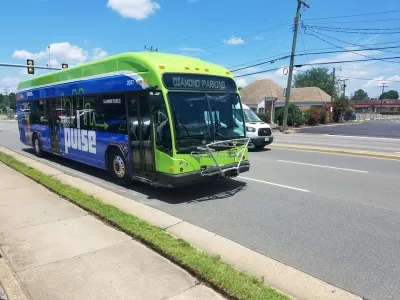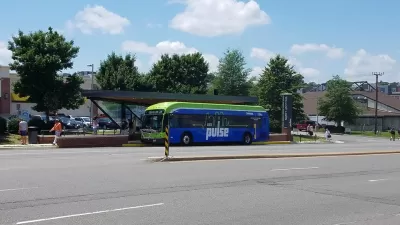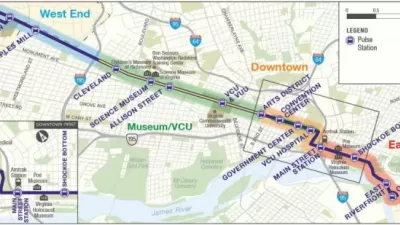The three-year program will expand transit to rural and suburban areas that currently lack access to the region’s fixed-route bus lines.

A three-year microtransit pilot program run by the Greater Richmond Transit Company (GRTC) is coming to six localities in the greater Richmond, Virginia area, reports Wyatt Gordon in Greater Greater Washington.
The program aims to “close mobility gaps in rural and suburban parts of the region via an on-demand system that will allow people to book rides in real time and get picked up and dropped off in designated areas.”
The need is real: “Of the 2,165 square miles which comprise the Greater Richmond region, GRTC’s fixed-route bus service currently only covers 9% of that area, leaving the vast majority of Central Virginia’s more than one million residents with no other options to get around besides owning a private vehicle,” Gordon explains.
The pilot will also give officials insight into transit demand in previously underserved areas. “Such service is an easy way to test demand in areas whose demographics and land use patterns are conducive to transit but don’t yet enjoy any public transportation.”
Details about the type of vehicles to be used in the fleet, fares, and other program elements are yet to be decided. The program is funded in part by a grant from the Department of Rail and Public Transportation’s Transit Riders Incentive Program.
Transit agencies around the country are exploring microtransit and on-demand transit as cost-effective options for expanding or maintaining transit service as commuting patterns and transit demand change and fare revenues remain below pre-pandemic levels.
FULL STORY: New microtransit program will expand mobility across six Richmond region localities

Study: Maui’s Plan to Convert Vacation Rentals to Long-Term Housing Could Cause Nearly $1 Billion Economic Loss
The plan would reduce visitor accommodation by 25,% resulting in 1,900 jobs lost.

North Texas Transit Leaders Tout Benefits of TOD for Growing Region
At a summit focused on transit-oriented development, policymakers discussed how North Texas’ expanded light rail system can serve as a tool for economic growth.

Using Old Oil and Gas Wells for Green Energy Storage
Penn State researchers have found that repurposing abandoned oil and gas wells for geothermal-assisted compressed-air energy storage can boost efficiency, reduce environmental risks, and support clean energy and job transitions.

From Blight to Benefit: Early Results From California’s Equitable Cleanup Program
The Equitable Community Revitalization Grant (ECRG) program is reshaping brownfield redevelopment by prioritizing projects in low-income and environmental justice communities, emphasizing equity, transparency, and community benefits.

Planting Relief: Tackling Las Vegas Heat One Tree at a Time
Nevada Plants, a Las Vegas-based nonprofit, is combating the city’s extreme urban heat by giving away trees to residents in underserved neighborhoods, promoting shade, sustainability, and community health.

How Madison’s Tree Planting Efforts Are Growing a Healthier Community
Madison’s annual tree planting initiative is enhancing environmental resilience, public health, and community livability by adding 1,400 carefully selected trees citywide, with strong community and institutional support for urban forestry.
Urban Design for Planners 1: Software Tools
This six-course series explores essential urban design concepts using open source software and equips planners with the tools they need to participate fully in the urban design process.
Planning for Universal Design
Learn the tools for implementing Universal Design in planning regulations.
Ascent Environmental
Borough of Carlisle
Institute for Housing and Urban Development Studies (IHS)
City of Grandview
Harvard GSD Executive Education
Toledo-Lucas County Plan Commissions
Salt Lake City
NYU Wagner Graduate School of Public Service





























